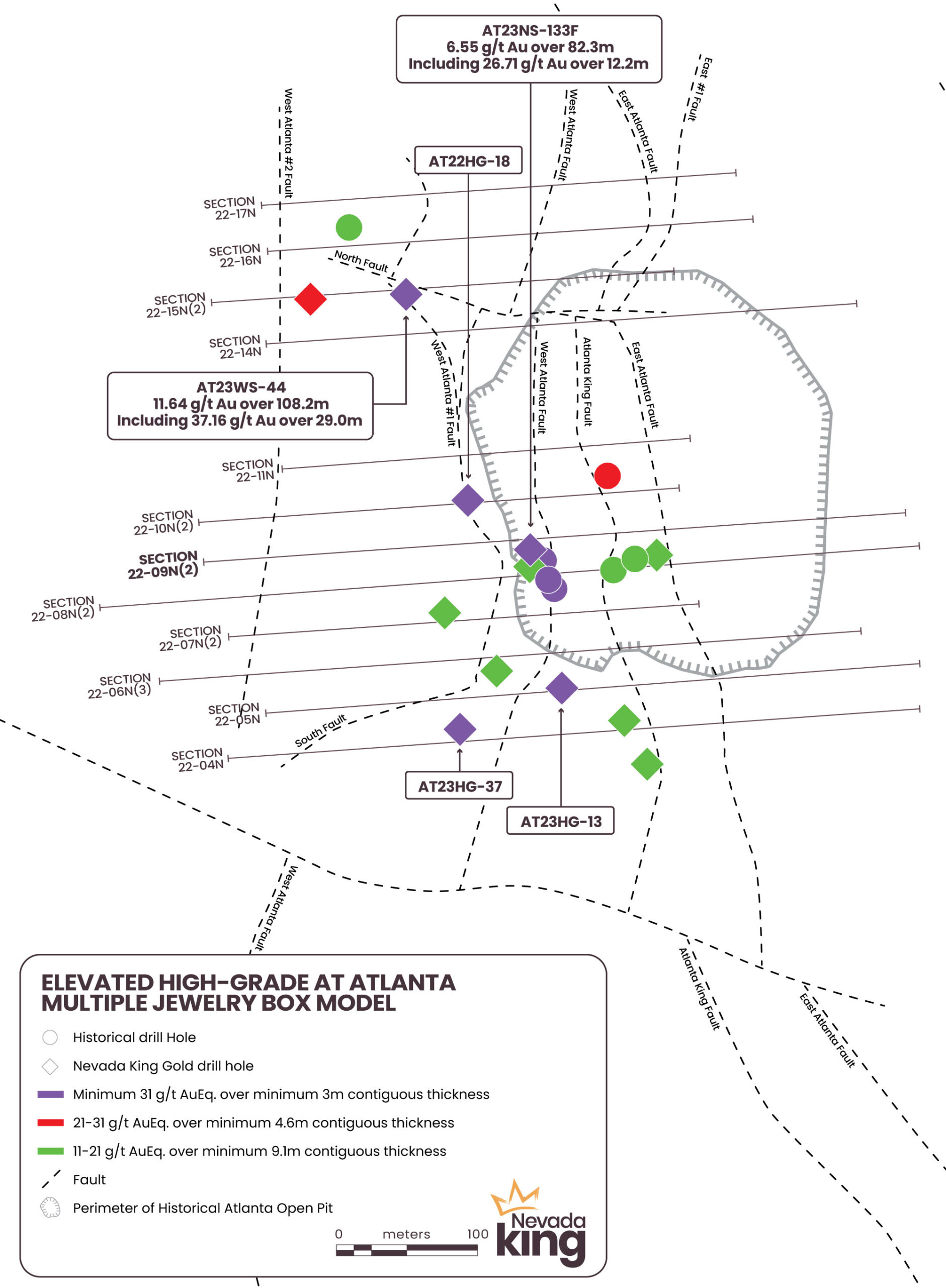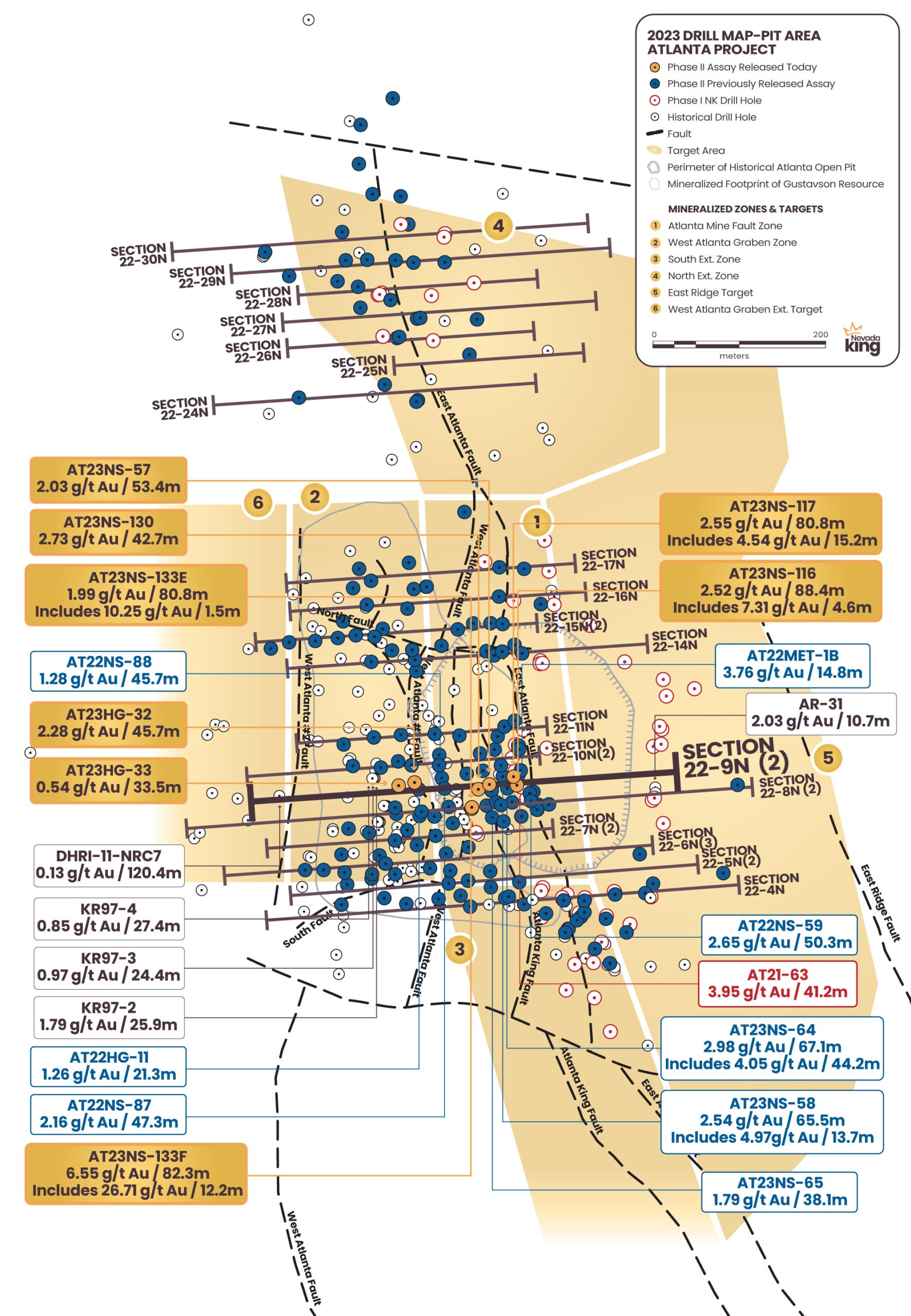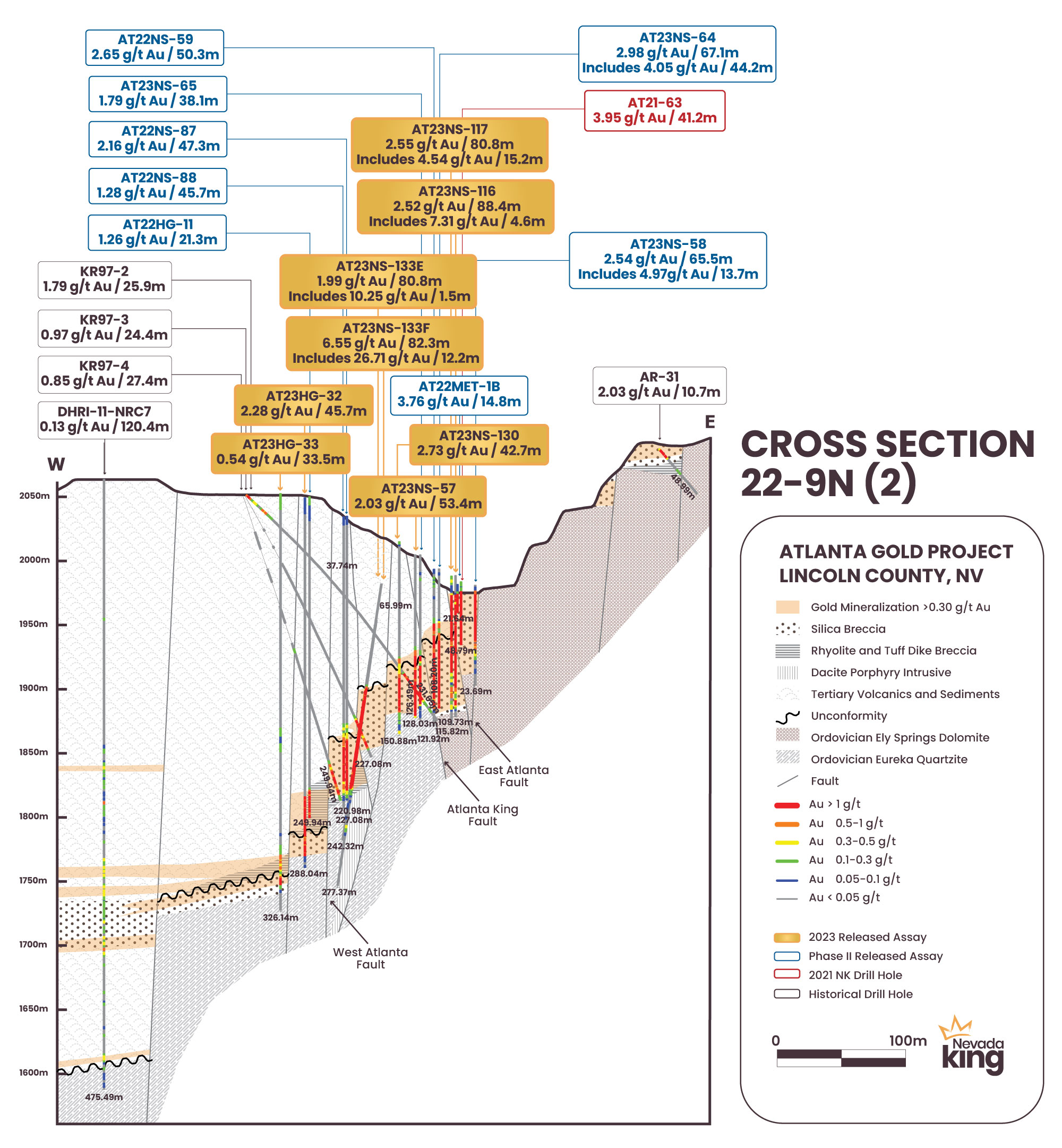VANCOUVER, BC, November 14, 2023 – Nevada King Gold Corp. (TSX-V: NKG; OTCQX: NKGFF) (“Nevada King” or the “Company”) is pleased to announce assay results from eight reverse circulation (“RC”) holes from its 60,000 metre Phase II drilling program at its 5,166 hectare (51.6km2) Atlanta Gold Mine Project, located in the prolific Battle Mountain Trend, 264km northeast of Las Vegas, Nevada. Four of the holes targeted the Atlanta Mine Fault Zone (“AMFZ”) while the other four tested the adjacent West Atlanta Graben Zone (“WAGZ”), see Section 22-9N(2) in Figures 2 and 3 below.

- 6.55 g/t Au and 100.8 g/t Ag over 82.3m, including 26.71 g/t Au over 12.2m in angle hole AT23NS-133F is the third most gold rich drill hole ever recorded at Atlanta and comes on the heels of the most gold rich drill hole ever recorded at the project – AT23WS-44 that was reported on October 2, 2023 and returned 11.64 g/t Au over 108.2m, including 37.16 g/t Au over 29.0m.
- Previous drilling by Nevada King in the vicinity of today’s AT23NS-133F provided little indication of such high-grade, although two historical holes drilled by Bobcat in 1988 and one hole drilled by Goldfields in 1990 (see Figure 1) did contain elevated high-grade intervals in the same general area. Results for vertical Bobcat holes 88-9 (12.2m @ 32.55 g/t Au – the second most gold rich drill hole at Atlanta) and 88-14 (3m @ 34.66 g/t Au) were not included in Gustavson’s 2020 resource model because of uncertain collar locations, while vertical Goldfields core hole AC-1 (4.1m @ 30.24 g/t Au) was used in the 2020 resource model, but its exact collar location was also uncertain. The high-grade hit in AT23NS-133F corroborates both the locations and high grades in these nearby historical holes and establishes a northwest-trending, elevated high-grade zone at least 30m long that is interpreted to be a tensional, secondary fracture in the footwall of the West Atlanta Fault that probably connects across the major northerly trending feeder faults. This intercept supports the multi-jewelry box model recently described by the Company in its October 2, 2023 release and provides us with another structural target that we can apply to other portions of the deposit in our pursuit of elevated high grades.
- Note, AT23NS-133F is hosted along the east side of the West Atlanta Fault, whereas AT23WS-44 is located 200m to the northwest along the West Atlanta Fault #1 – a different structure. As depicted in Figure 1 below, several occurrences of elevated high-grade mineralization have been found throughout the Atlanta deposit by both Nevada King (holes indicated by diamonds) and historical operators (holes indicated by circles). Holes colored in purple designate a >31 g/t AuEq over a minimum 3m continguous thickness, while red refers to 21-31 g/t AuEq over a minimum 4.6m continguous thickness, and green shows 11-21 g/t AuEq over a minimum of 9.1m contiguous thickness. Of all the holes hosting elevated high-grade intercepts, only AT23NS-133F occurs proximal to other holes hosting similar grades. For the remaining elevated high-grade holes there are no nearby drill intercepts that definitively suggest proximity to very high-grade mineralization, which highlights the necessity for tight drill spacing, focused on high-angle feeder structures.

Cal Herron, Exploration Manager of Nevada King, stated, “Nevada King’s 2021 Phase I drill program revealed potential for significantly expanding the shallow high-grade mineralization around the pit and into the North Extension Target 500m north of the pit. The 2022 drill program saw development of our current geological model propounding high-angle fault control over higher grade mineralization within a relatively sub-horizontal replacement horizon together with realization of the potential posed by the West Atlanta Graben Zone for significantly increasing the size of the deposit. In 2023, our focus shifted to sharpening definition of high-grade feeder structures, while the recent discovery of elevated high-grade gold mineralization, now in two different parts of the deposit, has whetted our appetite for more bonanza-type mineralization.
“As shown in Figure 1 above the overall distribution of higher-grades is controlled by northerly-trending, high-angle faults that served as feeders (or conduits) for mineralizing fluids; however, the distribution of elevated high grade mineralization appears to be more controlled by secondary faults that cut across the primary feeder structures at angles around 30o to 45o. These secondary structures form in reponse to stress building up between the main fault strands, forming tensional “gash dilations” that often focus boiling within the openings, thus resulting in bonanza-grade chutes. Bonanza chutes are common within Au-Ag hydrothermal deposits and were the object of historical mining activity around the world. Finding such bonanza chutes in this day and age is a rarity and these extremely high-grade, but small zones can have an outsized impact on a deposit’s economics. Right now, it looks like we may have several such bonanza chutes shaping up at Atlanta, which will make for a very busy winter of testing.”
Additional Highlights:
- Hole AT23NS-133E was sited at the same collar location as AT23NS-133F and hit 1.99 g/t Au and 118.45 g/t Ag over 80.8m including 10.25 g/t Au over 1.5m in the same fault block, but about 35m away from AT23NS-133F. Both holes entered and exited the mineralized horizon at similar depths, and more importantly, both holes exited the base of the high-grade zone (196.6m in NS-133F and 198.2m in NS-133E) at almost the exact same depth, indicating that the high-grade “core” zone is most likely sub-horizontal, not high angle.
- AT23NS-116 (88.4m @ 2.52 g/t Au and 50.4 g/t Ag) and AT23NS-117 (80.8m @ 2.55 g/t Au and 40.1 g/t Ag) were drilled immediately west of the East Atlanta Fault (“EAF”) to verify the “V” shaped reverse fault wedge formed between two northerly-trending faults. Both holes penetrated the high-grade wedge and drilled through the down-faulted block occurring beneath the wedge, doubling the known combined thickness of the mineralized zone. Establishing this “couplet” geometry is important as both fault blocks occur near-surface, are strongly oxidized, and contain moderate to high-grade gold, and as such could play an important role in any future mining scenario. This same structural couplet is observed for at least 200m in sections previously reported both north and south of Section 22-9N(2).
- AT23HG-32 (45.7m @ 2.28 g/t Au and 145.5 g/t Ag) was collared 17m west of the West Atlanta Fault and twinned failed hole AT22HG-11 (21.3m @ 1.26 g/t Au and 85.1 g/t Ag) that was lost in the mineralized zone. Simply achieving full drill penetration of the entire mineralized zone almost doubles both thickness and grade, which is a common theme at Atlanta throughout the deposit and mandates re-drilling holes that did not go deep enough.
- AT23HG-33 (33.5m @ 0.54 g/t Au and 83.7 g/t Ag) stepped 20m west of HG-32 and we now see an abrupt drop in gold mineralization but the silver grade remains elevated. Additional drilling will continue to track the mineralization westward across the WAGZ in anticipation of hitting higher-grade and thickness closer to the West Atlanta #2 Fault as observed to the north and south.
Comparison of Nevada King and Historical Holes along Section 22-9N(2):
- Targeting the high-grade feeders is showing very high-grade results that can significantly impact the overall resource. Table 2 below summarizes averaged drill hole intercepts for the Company’s holes and for historical holes that were included in the Gustavson 2020 resource model along Section22-9N(2). Looking at just the drilling across the AMFZ, the four Kinross angle holes average 1.65 g/t Au equivalent over an average 25.9m thickness whereas the sixteen Nevada King holes average 3.73 Au equivalent over an average 50.4m thickness, representing a doubling in average thickness and more than a doubling of average grade.
- This discrepancy in both thickness and grade is largely attributed to three factors: (1) the Kinross angle holes missed (as did almost all of the historical holes) the higher-grade and thicker structural couplet between the East Atlanta and Atlanta King Faults, (2) Nevada King’s holes did a much better job of fully penetrating the entire mineralized thickness in each fault block compared to Kinross’ angle holes, and (3) Nevada King’s holes did a much better job of testing the high-grade feeder structures that historical explorers failed to recognize. The very high-grade intercept in AT23NS-133F also exerted a strong influence on Nevada King’s average grade.




QA/QC Protocols
All RC samples from the Atlanta Project are split at the drill site and placed in cloth and plastic bags utilizing a nominal 2kg sample weight. CRF standards, blanks, and duplicates are inserted into the sample stream on-site on a one-in-twenty sample basis, meaning all three inserts are included in each 20-sample group. Samples are shipped by a local contractor in large sample shipping crates directly to American Assay Lab in Reno, Nevada, with full custody being maintained at all times. At American Assay Lab, samples were weighted then crushed to 75% passing 2mm and pulverized to 85% passing 75 microns in order to produce a 300g pulverized split. Prepared samples are initially run using a four acid + boric acid digestion process and conventional mutli-element ICP-OES analysis. Gold assays are initially run using 30-gram samples by lead fire assay with an OES finish to a 0.003 ppm detection limit, with samples greater than 10 ppm finished gravimetrically. Every sample is also run through a cyanide leach for gold with an ICP-OES finish. The QA/QC procedure involves regular submission of Certified Analytical Standards and property-specific duplicates.
Qualified Person
The scientific and technical information in this news release has been reviewed and approved by Calvin R. Herron, P.Geo., who is a Qualified Person as defined by National Instrument 43-101 (“NI 43-101”).
About Nevada King Gold Corp.
Nevada King is the third largest mineral claim holder in the State of Nevada, behind Nevada Gold Mines (Barrick/Newmont) and Kinross Gold. Starting in 2016 the Company has staked large project areas hosting significant historical exploration work along the Battle Mountain trend located close to current or former producing gold mines. These project areas were initially targeted based on their potential for hosting multi-million-ounce gold deposits and were subsequently staked following a detailed geological evaluation. District-scale projects in Nevada King’s portfolio include (1) the 100% owned Atlanta Mine, located 100km southeast of Ely, (2) the Lewis and Horse Mountain-Mill Creek projects, both located between Nevada Gold Mines’ large Phoenix and Pipeline mines, and (3) the Iron Point project, located 35km east of Winnemucca, Nevada.
The Atlanta Mine is a historical gold-silver producer with a NI 43-101 compliant pit-constrained resource of 460,000 oz Au in the measured and indicated category (11.0M tonnes at 1.3 g/t) plus an inferred resource of 142,000 oz Au (5.3M tonnes at 0.83 g/t). See the NI 43-101 Technical Report on Resources titled “Atlanta Property, Lincoln County, NV” with an effective date of October 6, 2020, and a report date of December 22, 2020, as prepared by Gustavson Associates and filed under the Company’s profile on SEDAR+ (www.sedarplus.ca).
Please see the Company’s website at www.nevadaking.ca.
For more information, contact Collin Kettell at collin@nevadaking.ca or (845) 535-1486.
Neither the TSX Venture Exchange nor its Regulation Services Provider (as that term is defined in the policies of the TSX Venture Exchange) accepts responsibility for the adequacy or accuracy of this release.
Cautionary Statements Regarding Forward Looking Information
This news release contains certain “forward-looking information” and “forward-looking statements” (collectively “forward-looking statements”) within the meaning of applicable securities legislation. All statements, other than statements of historical fact, included herein, without limitation, statements relating the future operations and activities of Nevada King, are forward-looking statements. Forward-looking statements are frequently, but not always, identified by words such as “expects”, “anticipates”, “believes”, “intends”, “estimates”, “potential”, “possible”, and similar expressions, or statements that events, conditions, or results “will”, “may”, “could”, or “should” occur or be achieved. Forward-looking statements in this news release relate to, among other things, the Company’s exploration plans and the Company’s ability to potentially expand mineral resources and the impact thereon. There can be no assurance that such statements will prove to be accurate, and actual results and future events could differ materially from those anticipated in such statements. Forward-looking statements reflect the beliefs, opinions and projections on the date the statements are made and are based upon a number of assumptions and estimates that, while considered reasonable by Nevada King, are inherently subject to significant business, economic, competitive, political and social uncertainties and contingencies. Many factors, both known and unknown, could cause actual results, performance or achievements to be materially different from the results, performance or achievements that are or may be expressed or implied by such forward-looking statements and the parties have made assumptions and estimates based on or related to many of these factors. Such factors include, without limitation, the ability to complete proposed exploration work, the results of exploration, continued availability of capital, and changes in general economic, market and business conditions. Readers should not place undue reliance on the forward-looking statements and information contained in this news release concerning these items. Nevada King does not assume any obligation to update the forward-looking statements of beliefs, opinions, projections, or other factors, should they change, except as required by applicable securities laws.

